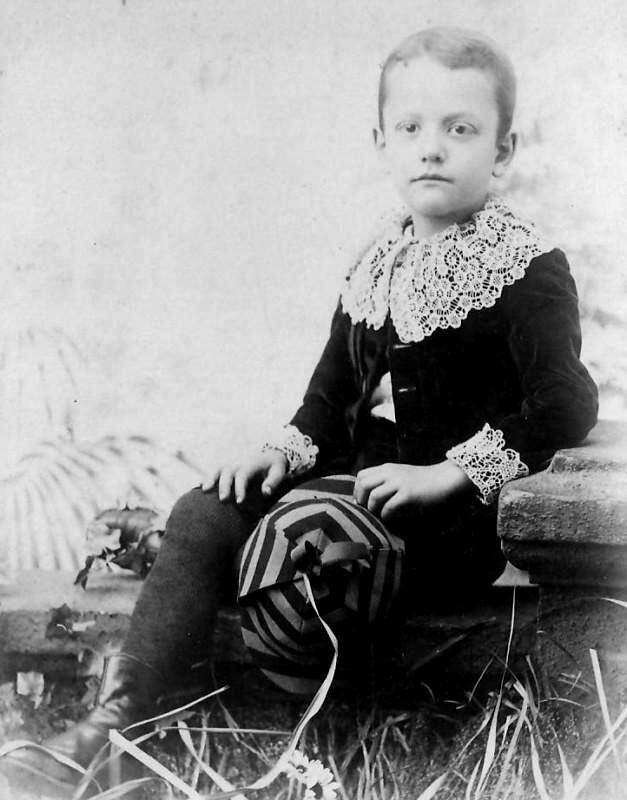
Cuffs on Boys' Shirts and Blouses: Lace Cuffs

Figure 1.--This Circleville, Ohio boy wears a classic velvet Fauntleroy suit with a large lace ciollar and matching trim. Note there is no fancy blouse front. The collar and cuffs do not seem to be part of what liiks like a plain short waist. Also notice the colorful jockey cap. The boy is unidentigied, but looks to be about 6 years old.
|
|
Both men and boys wore lace collars and wrist trim during
the Stuart Cavilier period . The style was strongly influenced all over Europe by the court of the famed Sun King (Louis XIV) who dominated Europe throughout the 17th cebtury. Lace in this era was part of a well-dresses gentleman's wardrobe and was just as popular if not more popular for mens' clothes than women's clothes. A later reincanation ocurred in the
1880s, especially in America, with the publication of Little Lord Fauntleroy. Fauntleroy suits, the fashion of velvet knee pants suits, worn with long curls, and lace collars plagued American boys for several decades. A great variety of laces and styles were used with the fancy blouses worn as an integral part of the Fauntleroy look. We note specically styled Fauntleroy collars and cuffs. Ruffled collars and cuffs were the most commom, but we see lace collars and cuffs as well.
The matching collars and cuffs were an important part of the Fauntleroy look. Blouses were made with fancy collars and cuffs, but sometimes lace trim was simply sewed on the jacket collar and cuff. Lace cuffs see pin on additions in contrast to ruffled cuffs which were part of the blouse. A good example is the lace collar and matching cuffs worn by an American boy, Ivan Eugene Perry, in 1906-07. Many boys during the 1880s and 1890s wore lace collars and wrist trim with their best party suit. In some cases it was worn with kilt or even dress outfits for the younger boys. It was probably the most hated boyhood fashion (at least by the boys) of all time. The lace collar itself was often one of the features of the Fauntleroy suit most disliked by the boys. There is an interesting little scene in Walt Disney's much over-looked film, Song of the South, dealing with the boy's distaste for the lace collar his mother insists that he wear. While the velvet Fauntleroy suit and lace collar may have been more popular in America thab Europe, lace trimmed boys' clothes were probably more common in France and Italy then elsewhere in Europe. Lace trimmed clothes were not nearly as popular in Germany.
HBC

Navigate the Historic Boys' Clothing Web Site:
[Return to the Main shirt cuff page]
[Introduction]
[Activities]
[Biographies]
[Chronology]
[Clothing styles]
[Countries]
[Theatricals]
[Topics]
[Bibliographies]
[Contributions]
[FAQs]
[Glossaries]
[Images]
[Links]
[Registration]
[Tools]
[Boys' Clothing Home]
Navigate the Historic Boys' Clothing Web chronological pages:
[The 16th Century]
[Early 1800s]
[The 1870s]
[The 1880s]
[The 1890s]
[The 1900s]
[The 1910s]
Navigate the Historic Boys' Clothing Web style pages:
[Dresses]
[Smocks]
[Bows]
[Bodice kilts]
[Kilts]
[Sailor suits]
[Eton suits]
[Blouses]
[Ring bearer/page costumes]
[Fauntleroy suits]
Created: 8:16 PM 10/3/2013
Last updated: 8:17 PM 10/3/2013



